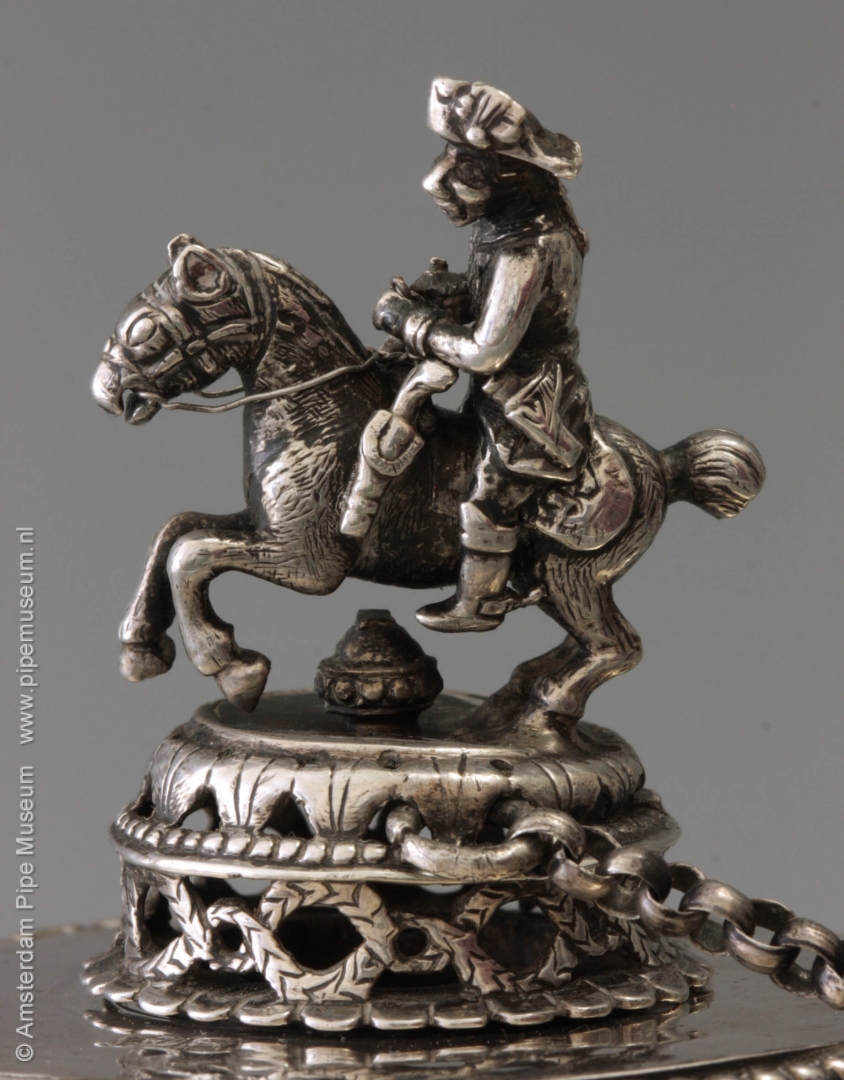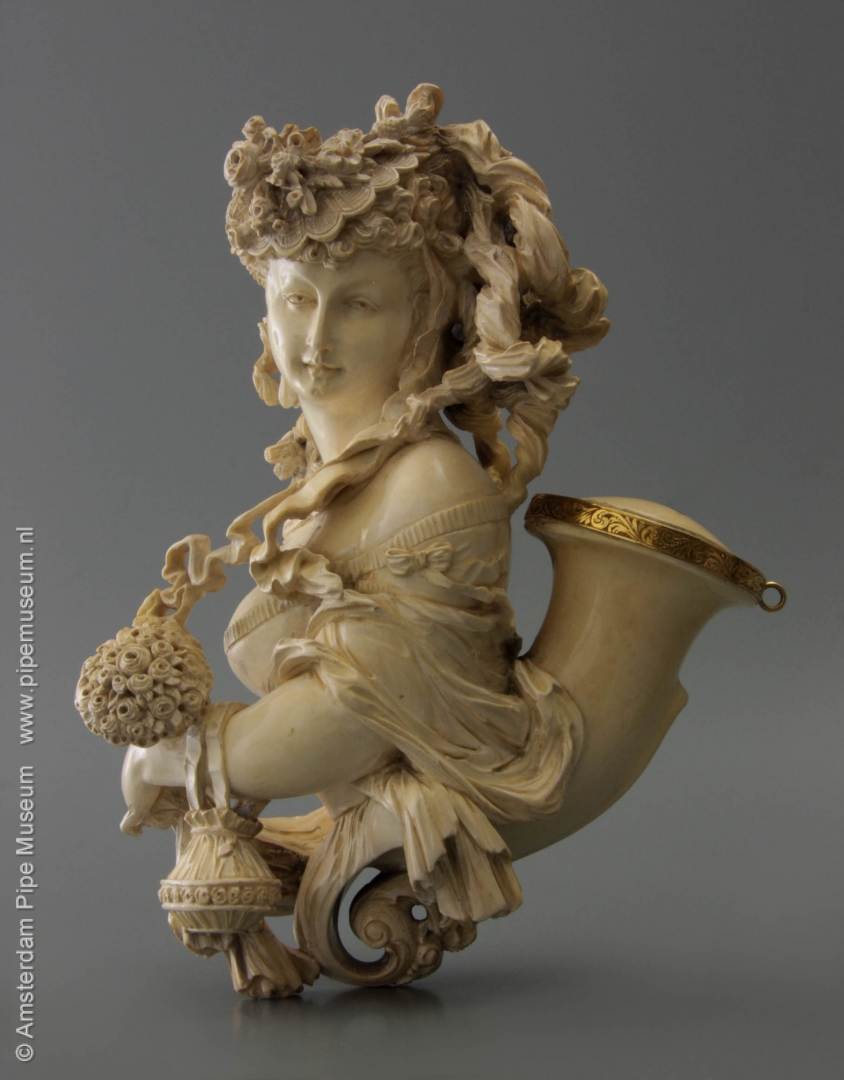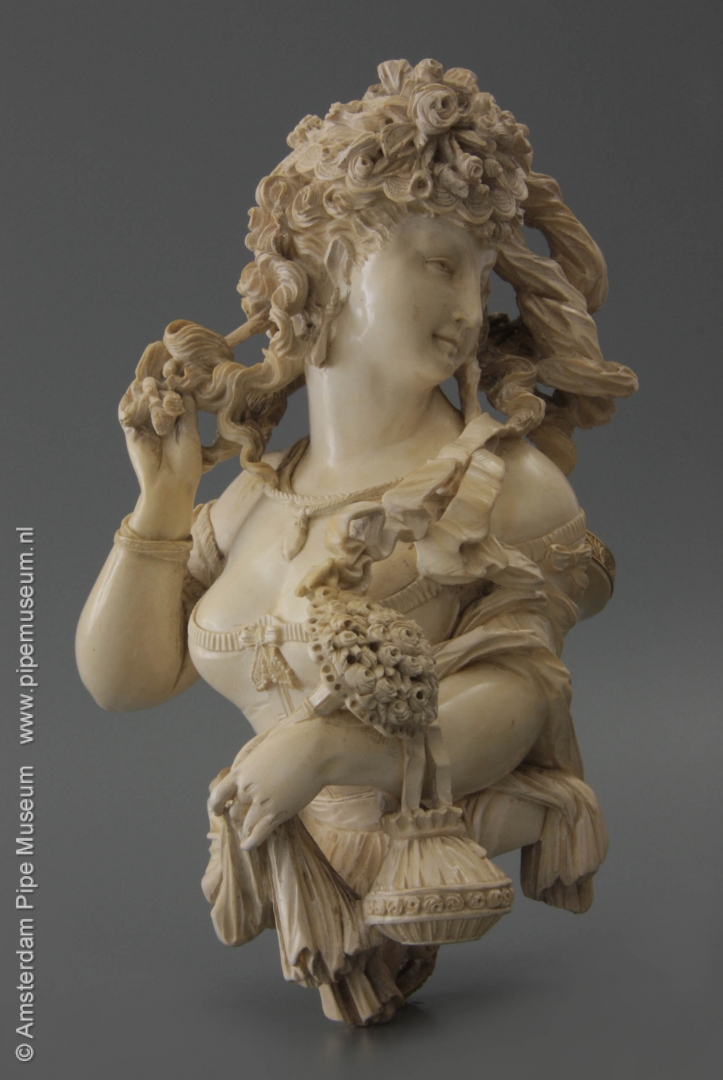Acquisitions: Three meerschaum pipes from the Trevor Barton collection
Auteur:
Don Duco
Original Title:
Aanwinsten: Drie meerschuimpijpen uit de Trevor Barton collectie
Année de publication:
2010
Éditeur:
Pijpenkabinet Foundation
Magazine:
Nieuwsbrief Pijpenkabinet
Description :
Description and illustration of three remarkable meerschaum tobacco pipes purchased for the collection of the Pijpenkabinet.
Late September this year an important auction took place at Christie's London. The auction comprised the important pipe collection of the late Trevor Barton, who passed away two years ago and is generally seen as the most dedicated English pipe collector of the twentieth century. The sale was an important event because at one time dozens of pipes became available that have not changed ownership for decades. The auction brought together collectors from all over Europe and those who were not personally present in the auction room participated in the event on internet. This special auction was reviewed by the art journalist Anne Crane in a richly illustrated article (click here for a link).
The Pijpenkabinet was attending and due to the high quality of the collection was interested in a lot of different items. However, given the international buyers potential, the material had to be shared with many other buyers. Nevertheless the Amsterdam museum acquired a fine set of pipes that reflect the high quality and the large variety of the Barton collection. Unfortunately, many items proved to be damaged over the last years, when the collector himself couldn’t handle the pipes very well. Three of the sixty acquisitions are discussed below, as usual within one collectors field: meerschaum pipes. Next to European objects we were able to buy also ethnographical pipes, American Indian as well as African pipes. These items will surely be published in future.
An early bag-shaped pipe
The early history of the meerschaum pipe is still misty. Limited archival research and very little items datable by their signatures or marks, make that we are poorly informed about the eighteenth century meerschaum pipe industry and its products. The purchase of an early meerschaum with late rococo details is a welcome addition to the collection of the Pijpenkabinet, that aims at an equal distribution of examples over time.


The acquired pipe is a large example of the so-called bag shape: the base of the pipe is bulbous and massive, the bowl gets wider to the opening till almost a funnel shape, the other end shows an upward going stem also widening towards the stub. Typical for this pipe is the so-called bridge, the stub being connected with the bowl with a thin ornament in meerschaum, covered with silver on the top. This remarkable but characteristic design gives the pipe its elegant appearance.
De subject of decorations on the bowl illustrates a scene gallante with a hunter and a well dressed lady of fairly fine carving. The figures are framed by ornaments in the late rococo style. Because these late rococo style characteristics the pipe looks like an item produced during the revival of the rococo in the mid-nineteenth century. Nevertheless the silver marks on the mounting clearly show the date of origin: 1781. The initials of the maker refer to Johannes Christofourus Stieger from Bratislava working in that period. One would expect that a pipe of this quality would be made in Vienna, but this one proves to originate from the what is now-a-day the Czech Republic - as unexpected as its early dating.
The mounting of the pipe is remarkable. On the lid a cast statuette of Frederic the Great on horseback is attached in a way that the royal can move free from the horse, tied by the reigns. This luxurious addition to the lid made the pipe suitable for a royal smoker or ardent royalist. In those circles the pipe will have been smoked over a long time, as proven by its brown patina. The pipe was one of Barton’s favourites, probably because he dated the piece earlier than possibly feasible. He presumed it dated from the year 1721 a wishful thinking because that date was long before the birth of the rococo style. With that misleading dating this fine piece was exhibited at the prestigious exhibition entitled “Five Hundred years of Tobacco Culture” that took place in Vienna in 1992; the pipe was illustrated in the catalogue as well.
Amsterdam, Pijpenkabinet collections Pk 20.315
The utmost in elegance
In the auction catalogue of Christie's a full page is dedicated to this magnificent tobacco pipe. This is understandable, because it concerns an astonishing detailed pipe, absolutely over the top in elegance and mannered style. Depicted is an elegant lady possessing all the accessories you can imagine. Her fancy dress, giving sight to a necklace with hangers, is finished with a scarf draped to all sides, of which she holds the final end in her hand. On her arm she wears a small basked like bag, holding a bunch of flowers at the same time in her hand. The other hand is reserved for a small but coquette circular sun-shade of feathers on a small distance from her head, of course which - why not - shows a small hat with flowers in bloom.


The carver of this artistic piece achieved a sculpture, maybe not after everybody's taste, but certainly with a maximum of elegance, transparency and detail at all sides. From every point of view the lady looks different, giving new and unexpected views on and through its ultimate three-dimensionality; one might say that there is too much detail, which makes the overall effect also somewhat boring. Nevertheless this sculpture is also a perfect smoking pipe because it functionality is as normal. The head of the elegant lady is carefully hollowed out and a smoke tube leaves from there through her neck to meet up with the bore in the stem.
Perfectly matching is the fitted stem, not in wood with parts of buffalo horn but completely in ivory. The main part shows a double twisted part housing the hollow tube to transport the smoke. Focal point is an animal looking like a cat, with real robin as eyes inserts. The back of this ornament shows rather unexpected the head of a goat with eyes in moon stone. The flexible part of the stem is also more luxurious: it consists of ivory rings alternated with buffalo rings. Altogether, this pipe is an extremely fine piece in every detail. Rapaport in his book on meerschaum pipes lists this piece among the higher qualified pipes. However, in contrast to the previous pipe, this piece is more a showpiece than a usable utensil for smoking. In any case, the pipe has never been used, the bowl interior is as virgin as it was when produced.
Amsterdam, Pijpenkabinet collections Pk 20.313
A characteristic portrayal
This massive large meerschaum bowl is of completely different style than the previously discussed elegant lady. The bowl is carved out of a huge lump of meerschaum and depicts a Zouave head. The face is beautifully detailed with his tired eyes, lined face, big moustache and huge round beard. On his head he wears a cylindrical hat with a tassel hanging down resting on the upward going stem. Round the stub we see an elegant ring with stylized shell ornaments. With its large, massive appearance and masculine portrait this pipe bowl is the perfect counterpart to the women's head in the other pipe.


This one is not a mannerist product but a sturdy pipe for an older male smoker. The bowl is large in size and the thick meerschaum body guaranties a perfect cool and dry smoke, securing a comfortable and optimal smoking pleasure. Interesting aspect of the carving are the curly hairs of the beard, so numerous that it seems impossible that they have been carved individually. At closer look you can see that the knife used for the beard consisted of several small knifes that made it possible to carve several curls in one stroke. A tool like that saved a lot of hand labour while it did not affect the result negatively.
Pipe bowls like these are generally known from the first decade of the twentieth century when they were made by series in the Vienna workshops, however in standard size. Though skilful, there were numerous makers that were able to carve these type of bowls. This pipe however, does not have the standard size but is much larger: the height of the bowl measures over 16 centimetres! It must date from an earlier period, roughly fifty years earlier. That is also proven by the fitting case that fortunately still is with the pipe. The case is covered with black leather, while the inside is lined with red velvet to protect the fragile carvings. Two openings of the case set the bowl and the stem free so that the pipe could be smoked when still in the case. A fashion statement of an earlier time, when the meerschaum was fully protected during the smoking.
Unfortunately the maker of this imposing tobacco pipe is not known and this will probably be a secret in future. The only indication of pedigree is the name of the dealer in gold lettering on the rim of the case. It concerns C.A. Carlin who owned a shop in Regent Street number 145 in London. The date should lie between 1865 and 1880. That also Trevor Barton appreciated this pipe is proven by the fact that it was published twice, although this happened in the beginning of his collecting career, in the nineteen fifties and sixties. Thereafter he appeared with other pipes in publications, but the pipe was not forgotten. I very well remember he proudly took the item out when I visited him for the first time in the early 1980's.
Amsterdam, Pijpenkabinet collections Pk 20.314
© Don Duco, Pijpenkabinet Foundation, Amsterdam – the Netherlands, 2010.